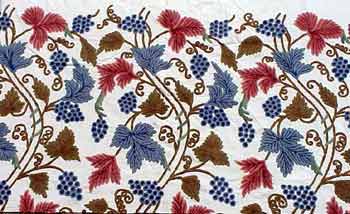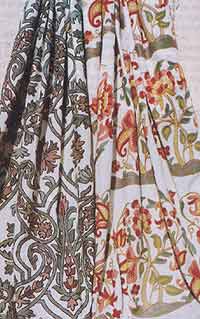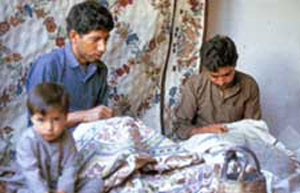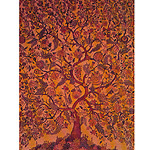Kashmiri embroidery, popularly known as Kashida, along with the Kashmiri carpet industry, is one of the biggest commercial crafts of India. Though the embroidery originated in the form of shawl ornamentation, it is now used to decorate a range of articles including yardage, home furnishings, jackets, coats, mufflers, jutis (leather footwear) etc.
Kashida has several forms
- Zalakdozo (a chain stitch done with hook on almost every fabric from shawl to floor covering)
- Suzni (only done on fine fabrics using three types of stitches. The embroidery is completely symmetrical on either ends of the fabric)
- Vata chikan (buttonhole stitch used to cover large sections of the fabric. Landscapes and crowded scenes are commonly depicted)
- Do-rookha (double sided work where both sides of the fabric are mirror images)
- Amli (a new innovation in kani or jamevar shawl, delicate filling with stitches using multicoloured threads in elaborate all over patterns to enhance the fine layout of the kani).
ABOUT Crewel Embroidery
Crewel or Hook embroidery, locally known as Zalakdozi, is one of the specialized styles of embroidery practiced in Kashmir. Several articles are made using this embroidery – Namda (felt carpet), dress material and curtain cloth. The base cloth is the same for these items and that determines what the product will be used for and what manner of decoration will be done on it.
 |

DESIGNS AND COLOURS
The designs range from Persian to French, from Chinar leaf (Chinar is an important tree in the Valley and its leaf has been amply used in embroidery), Shikargarh (hunting scenes), Theridar, Bulbuldar, Guldar, Badamadar (buta resembling an almond which is believed to be in use from the first quarter of the 18th century), Kalka (most popular flame shaped motif) etc.
 |


PROCESS
The design is traced onto the fabric by professional tracers called Naquashband. They have perforated sheets with innumerable designs and they lay these sheets on the fabric and chalk or charcoal powder is rubbed over it, which leaves the impression of the design on the fabrics surface. Gum Arabic or oil is added to the powder to make the tracing durable. The outlines are highlighted using a wooden pen (kalam).
 |

After tracing the design, the embroider (zalakdoz) works with a hook needle (Ara Kunj) inserting the hook from the right while the thread is held on the underside. The design shows itself in the form of small loops. The work appears as a chain stitch on the surface. While maintaining the same quality, hook work covers a much larger area than needle work in the same amount of time.
The intrinsic worth of each piece lies in the sizes of the stitches and the yarn used. Tiny stitches are used to cover the entire area – the figures or motifs are worked in striking colours; the background in a single colour, made up of a series of coin sized concentric circles which impart dynamism and a sense of movement to the design. Stitches ought to be small, even sized and neat. The background fabric should not be visible through the stitches.
 |
Gallery
YOUR VIEWS
PRACTITIONERS: INDIA
Access 70,000+ practitioners in 2500+ crafts across India.
BIBLIOGRAPHY
10,000+ listings on arts, crafts, design, heritage, culture etc.
GLOSSARY
Rich and often unfamiliar vocabulary of crafts and textiles.
SHOP at India InCH
Needs to be written.





